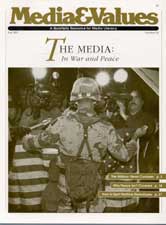Living Room Wars: Vietnam vs. 'Desert Storm'
|
This article originally appeared in Issue# 56
|
"The collapse of America's "will" to fight in Vietnam resulted from a political process of which the media were only one part...It is hard to see how, short of a real turn to authoritarian government, political doubt and controversy could have been contained much longer.
What can be said is that such issues as what was best for the people of Indochina and how substantial a national interest did the U.S. have in its political struggles were never seriously discussed in news coverage of the war, not, at any rate, in the New York Times coverage during the years when the decision was made to intervene, or in television coverage in subsequent years.
They were not discussed because the constraints of ideology and of journalistic routines tying news coverage to Washington perspectives excluded them from the news agenda. From this angle the implications of government control over the media look very different...Those who imagine that political elites would govern better without the press and the public looking over their shoulders should look back to the decision-making process of the early 1960s that lead to American intervention in Vietnam. In the case of Vietnam, excessive authority looks more like the source of imbalance than excessive democracy."
--Daniel C. Hallin, "The Uncensored War": The Media and Vietnam
One of the most persistent myths about Vietnam is the idea that saturation coverage on television turned the public against the war and that by extension any televised war will lose public support. This assumption motivated the British to place heavy restrictions on television during the Falklands war, and is one of the major reasons the American media in the Gulf faced military censorship for the first time since Korea.
The truth is that television was very far from showing the "true horror of war" in Vietnam, although it wasn't military restrictions that limited what we saw. The limits were mainly imposed by television's own relation to its audience, to its government and military sources, and to the soldiers who were the principal characters in the drama of "the living room war." These factors affected what we saw in the Gulf as well, far more than military restrictions, tight as these may have been.
The main story for television in the early years of the "living room war" was "American boys in action." The networks assumed, probably correctly, that this kind of "up close and personal" reporting would appeal most strongly to the public. The morale of American troops was very good when the war began, and most television coverage was filled with vignettes of brave soldiers and their powerful weaponry, which of course made wonderful visuals for TV. The "big picture" was filled in by military planners. The networks' own policies, meanwhile, limited graphic portrayals of casualties. "Producers and editors must exercise great caution before permitting pictures of casualties to be shown," said one CBS directive. "Shots can be selected that are not grisly, the purpose being not to avoid showing the ugly side of war, but rather to avoid offending families of war victims." This policy, however well-intentioned, had the effect of sanitizing television's image of war.
Television coverage did not become substantially more sober until the public, Washington officials and the soldiers in the field had already lost confidence that the war could be won. Television, in other words, was more a follower than a leader of public opinion.
Much of the public seems also to assume that the media in Vietnam were a threat to military security, judging from polls that show support for tight restrictions on journalists in the Gulf. But this is also incorrect. Several examinations of the voluntary guidelines used in Vietnam, which were far looser than restriction on journalists in the Gulf, found that these guidelines worked well. This was the conclusion reached by a Twentieth Century Fund task force on the military and the media, as well as a study by William M. Hammond of the Army's Office of Military History.
Today's living room war is not so different from that of 1965. Images of technology still fascinate, although the far glitzier "smart bomb" videos have replaced the old bomb-sight films of Vietnam. The media's military analyses, presented in a language drained of any sense of the political meaning or human cost of war, echo the earlier war reporting.



